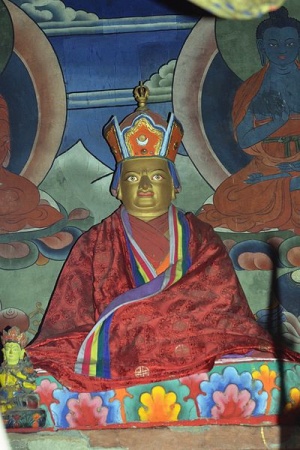Pema Lingpa
Pema Lingpa or Padma Lingpa (Tibetan: པདྨ་གླིང་པ་, Wylie: padma gling pa) (1450–1521) was a famous saint and siddha of the Nyingma school of Tibetan Buddhism. He was a preeminent terton (discoverer of spiritual treasures), and is considered to be foremost of the Five Terton Kings. In the history of the Nyingma school in Bhutan, Pema Lingpa is second only in importance to Padmasambhava himself.
Biography
Pema Lingpa was born in Chel, part of the central Bhutanese region of Bumthang known as the “Wheel of Dharma.” His father was Lama Döndrup Zangpo of the Nyö clan, and his mother, Drogmo Pema Drolma, was bestowed with all the signs of a dakini. Their son was born among many miraculous signs. As an incarnation of the Omniscient One Drimé Ozer (Longchenpa), Pema Lingpa was extraordinary even as a child. He learned everything from reading and writing to ironwork and carpentry without receiving any instruction.
On the tenth day of the first month of autumn in a Monkey Year, Guru Rinpoche appeared before Pema Lingpa at the holy site of Yigé Drukma, blessed him, and placed in his hands an inventory of one hundred and eight major termas to be revealed. However, due to the karmic disposition of beings at that time, during his lifetime Pema Lingpa revealed only about half of the prophesied treasures. Nevertheless, the revealed treasures of Pema Lingpa contain the essence of all 108 treasures, which are summarized in the cycles of the three heart practices transmitted to Princess Pemasel by Guru Rinpoche: The Lama Jewel Ocean, The Union of Samantabhadra's Intentions, and The Great Compassionate One: The Lamp That Illuminates Darkness.
The most famous story of Pema Lingpa tells of his diving with a burning butter lamp into Membartso, the so-called flaming lake in the Bumthang district of Bhutan (actually a deep pool in a river). He told onlookers that if he was a false spirit his lamp would be extinguished. Disappearing into the bottom of the gorge and feared drowned, he emerged from the water with a statue the size of a fist and a treasure casket tucked under one arm, and the butter lamp still burning in the other.
The extraordinary enlightened activities of Pema Lingpa magnetized a following of ordinary people as well as many significant political and spiritual figures of his time. He was highly regarded by all four of the principal schools of Vajrayana Buddhism. Pema Lingpa spent his life revealing the precious treasures of Guru Rinpoche, giving empowerments and teachings, meditating in isolated locations, building and restoring monasteries, and establishing a tradition that endures to this day. Moreover, Pema Lingpa prophesied that in the future he would return as the Buddha Dorjé Nyingpo in the pure land of Pemakö, and that those connected with him would be reborn in Pemakö as Buddha Dorjé Nyingpo’s students.
Notable descendants of Pema Lingpa include the Bhutanese royal family and the sixth Dalai Lama. The entire stream of the Pema Lingpa lineage of empowerments, transmissions and guidance continues today without decline. It is carried on through the three lines of the Body, Speech, and Mind emanations of Pema Lingpa: the Gangteng, Sungtrul, and Tukse Rinpoches, all of who traditionally reside in Bhutan.
Emanation Lineages
Traditionally, there are three main emanation lineages of Padma Lingpa recognized:
- the Peling Sungtrul incarnations who are considered to be the speech emanations;
- the Peling Tukse incarnations, the mind incarnations; and
- the Gangteng Tulku or Peling Gyalse incarnations who are considered to be the combined body and activity incarnations.
Peling Sungtrul incarnations:
- Tenzin Drakpa བསྟན་འཛིན་གྲགས་པ (1536–1597)
- Kunkhyen Tsultim Dorje ཀུན་མཁྱེན་ཚུལ་ཁྲིམས་རྡོ་རྗེ (1680–1723)
- Dorje Mikyō-tsal རྡོ་རྗེ་མི་སྐྱོད་རྩལ aka Ngawang Kunzang Rolpai Dorje ངག་དབང་ཀུན་བཟང་རོལ་པའི་རྡོ་རྗེ (1725–1762)
- Kunzang Tsewang ཀུན་བཟང་ཚེ་དབང aka Tenzin Drubchog Dorje བསྟན་འཛིན་གྲུབ་མཆོག་རྡོ་རྗེ (1763–1817)
- Kunzang Tenpai Gyaltsen ཀུན་བཟང་བསྟན་པའི་རྒྱལ་མཚན (1819–1842)
- Pema Tenzin པདྨ་བསྟན་འཛིན aka Kunzang Ngawang Chokyi Lodro ཀུན་བཟང་ངག་དབང་ཆོས་ཀྱི་བློ་གྲོས
- Kunzang Dechen Dorje ཀུན་བཟང་བདེ་ཆེན་རྡོ་རྗེ
- Tenzin Chōki Gyaltsen བསྟན་འཛིན་ཆོས་ཀྱི་རྒྱལ་མཚན (1843–1891)
- Pema Ōsal Gyurme Dorje པདྨ་འོད་གསལ་འགྱུར་མེད་རྡོ་རྗེ (1930–1955)
- Kunzang Pema Rinchen Namgyal ཀུན་བཟང་པདྨ་རིན་ཆེན་རྣམ་རྒྱལ (b. 1965) ~ the present Peling Sungtrul Rinpoche, Lhalung Sungtrul Rinpoche
Peling Tukse incarnations
- Tukse Dawa Gyaltsen ཐུགས་སྲས་ཟླ་བ་རྒྱལ་མཚན (b. 1499) - son of Pema Lingpa
- Nyida Gyaltsen ཉི་ཟླ་རྒྱལ་མཚན
- Nyida Longyang ཉི་ཟླ་རྒྱལ་མཚན
- Tenzin Gyurme Dorje བསྟན་འཛིན་འགྱུར་མེད་རྡོ་རྗེ (1641-ca.1702)
- Gyurme Chogdrub Palzang འགྱུར་མེད་མཆོག་གྲུབ་དཔལ་འབར་བཟང་པོ (ca. 1708-1750)
- Tenzin Chokyi Nyima བསྟན་འཛིན་ཆོས་ཀྱི་ཉི་མ (ca. 1752-1775)
- Kunzang Gyurme Dorje Lungrig Chokyi Gocha ཀུན་བཟང་འགྱུར་མེད་རྡོ་རྗེ་ལུང་རིགས་ཆོས་ཀྱི་གོ་ཆ (ca.1780-ca.1825)
- Kunzang Zilnon Zhadpa-tsal ཀུན་བཟང་ཟིལ་གནོན་བཞད་པ་རྩལ
- Thubten Palwar ཐུབ་བསྟན་དཔལ་འབར (1906–1939)
- Tegchog Tenpa'i Gyaltsen ཐེག་མཆོག་བསྟན་པའི་རྒྱལ་མཚན (1951–2010)
Peling Gyalse (Gangteng Tulku) incarnations
- Gyalse Pema Tinley རྒྱལ་སྲས་པདྨ་འཕྲིན་ལས (1564–1642)
- Tenzin Lekpai Dondrup བསཏན་འཛིན་ལེགས་པའི་དོན་གྲུབ (1645–1726)
- Tinley Namgyal འཕྲིན་ལས་རྣམ་རྒྱལ aka Kunzang Pema Namgyal (d. ca. 1750)
- Tenzin Sizhi Namgyal བསྟན་འཛིན་སྲིད་ཞི་རྣམ་རྒྱལ (1761?-1796)
- Orgyen Geleg Namgyal ཨོ་རྒྱན་དགེ་ལེགས་རྣམ་རྒྱལ (d. 1842 ?)
- Orgyen Tenpai Nyima ཨོ་རྒྱན་བསྟན་པའི་ཉི་མ (1873-1900?)
- Orgyen Tenpai Nyinjed ཨོ་རྒྱན་བསྟན་པའི་ཉིན་བྱེད
- Orgyen Thinley Dorje ཨོ་རྒྱན་འཕྲིན་ལས་རྡོ་རྗེ
- Rigdzing Kunzang Padma Namgyal རིག་འཛིན་ཀུན་བཟང་པདྨ་རྣམ་རྒྱལ (b. 1955) ~ present Gangteng Tulku Rinpoche
Source

